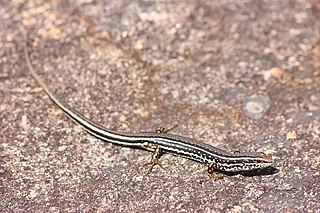The Hamelin ctenotus or Hamelin Pool ctenotus is a species of skink in the family Scincidae. It is found only in Western Australia.
Ctenotus alacer, the lively ctenotus, is a species of skink found in Northern Territory, Queensland, and Western Australia in Australia.
Ctenotus angusticeps, the northwestern coastal ctenotus, little leopard ctenotus, or Airlie Island ctenuous, is a species of skink found in Western Australia.

Ctenotus burbidgei, also known commonly as the plain-backed Kimberley ctenotus, is a species of skink, a lizard in the family Scincidae. The species is native to Western Australia.
Ctenotus decaneurus, the ten-lined ctenotus, is a species of skink found in Northern Territory and Western Australia.
Ctenotus duricola, the Eastern Pilbara lined ctenotus or Pilbara ctenotus, is a species of skink found in Western Australia.

Ctenotus gemmula, the jewelled south-west ctenotus, is a species of skink found in Western Australia.
Ctenotus halysis, the chained ctenotus, is a species of skink found in Western Australia.
Ctenotus iapetus, the North West Cape ctenotus, is a species of skink found in Western Australia.

Ctenotus labillardieri, also known commonly as the common south-west ctenotus, Labillardier's ctenotus, and the red-legged ctenotus, is a species of skink, a lizard in the family Scincidae. The species is endemic to the Australian state of Western Australia.

Ctenotus leonhardii, known by the common names Leonhardi's ctenotus, Leonhardi's skink or common desert ctenotus, is a species of skink found in a range of arid and semi-arid regions throughout mainland Australia. The species was named after German anthropologist Moritz von Leonhardi in 1919 and belongs to the genus Ctenotus, one of the largest genera of lizards in Australia.
Ctenotus nasutus, the nasute finesnout ctenotus, is a species of skink found in Northern Territory and Western Australia.
Ctenotus nigrilineatus, the pin-striped finesnout ctenotus, is a species of skink found in Western Australia.
Ctenotus rubicundus, the ruddy ctenotus, is a species of skink found in Western Australia.
The Tanami ctenotus is a species of skink found in the Northern Territory and Western Australia.
The Kimberley wedge-snout ctenotus is a species of skink found in the Northern Territory and Western Australia.
The spotted ctenotus is a species of skink found in Western Australia.
The wide-striped ctenotus is a species of skink found in Western Australia.
Ctenotus youngsoni, also known commonly as the Shark Bay south-west ctenotus and Youngson's ctenotus, is a species of skink, a lizard in the family Scincidae. The species is endemic to Australia. The specific name, youngsoni, is in honour of Australian zoologist William Kenneth Youngson. C. youngsoni is found in the Australian state of Western Australia. The preferred natural habitat of C. youngsoni is shrubland. C. youngsoni has well-developed limbs, with five toes on each of its four feet. C. youngsoni is oviparous.
Ctenotus fallens, the West-coast laterite ctenotus, is a species of skink found in Western Australia.




